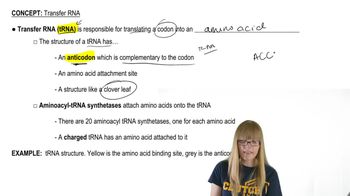For each of the anticodon sequences given in the previous problem, identify the other codon sequence to which it could potentially pair using third base wobble.
Table of contents
- 1. Introduction to Genetics51m
- 2. Mendel's Laws of Inheritance3h 37m
- 3. Extensions to Mendelian Inheritance2h 41m
- 4. Genetic Mapping and Linkage2h 28m
- 5. Genetics of Bacteria and Viruses1h 21m
- 6. Chromosomal Variation1h 48m
- 7. DNA and Chromosome Structure56m
- 8. DNA Replication1h 10m
- 9. Mitosis and Meiosis1h 34m
- 10. Transcription1h 0m
- 11. Translation58m
- 12. Gene Regulation in Prokaryotes1h 19m
- 13. Gene Regulation in Eukaryotes44m
- 14. Genetic Control of Development44m
- 15. Genomes and Genomics1h 50m
- 16. Transposable Elements47m
- 17. Mutation, Repair, and Recombination1h 6m
- 18. Molecular Genetic Tools19m
- 19. Cancer Genetics29m
- 20. Quantitative Genetics1h 26m
- 21. Population Genetics50m
- 22. Evolutionary Genetics29m
11. Translation
Transfer RNA
Problem 11b
Textbook Question
Consider translation of the following mRNA sequence:
5′-...AUGCAGAUCCAUGCCUAUUGA...-3′
What is the anticodon triplet sequence of the next tRNA to interact with mRNA?
 Verified step by step guidance
Verified step by step guidance1
Identify the mRNA sequence provided: 5′-AUGCAGAUCCAUGCCUAUUGA-3′. Translation begins at the start codon AUG.
Determine the codon sequence of the mRNA by dividing it into triplets starting from AUG: AUG, CAG, AUC, CAU, GCC, UAU, UGA. Note that UGA is a stop codon and does not code for an amino acid.
Focus on the second codon after AUG, which is CAG. This codon will be the next one to interact with a tRNA molecule.
Recall that tRNA molecules have anticodons that are complementary to the mRNA codons. Complementary base pairing rules are: A pairs with U, U pairs with A, G pairs with C, and C pairs with G.
Using the complementary base pairing rules, determine the anticodon for the codon CAG. The anticodon will be GUC.
 Verified video answer for a similar problem:
Verified video answer for a similar problem:This video solution was recommended by our tutors as helpful for the problem above
Video duration:
2mPlay a video:
Was this helpful?
Key Concepts
Here are the essential concepts you must grasp in order to answer the question correctly.
mRNA and Codons
mRNA, or messenger RNA, is a single-stranded nucleic acid that carries genetic information from DNA to the ribosome, where proteins are synthesized. Codons are sequences of three nucleotides in mRNA that correspond to specific amino acids or stop signals during translation. Understanding the codon sequence is essential for determining which tRNA will bind to the mRNA.
Recommended video:
Guided course

mRNA Processing
tRNA and Anticodons
Transfer RNA (tRNA) is a type of RNA that helps decode mRNA sequences into proteins. Each tRNA molecule has an anticodon, a triplet of nucleotides that is complementary to a specific mRNA codon. The interaction between the tRNA anticodon and the mRNA codon ensures that the correct amino acid is added to the growing polypeptide chain during translation.
Recommended video:
Translation Process
Translation is the process by which ribosomes synthesize proteins using the information encoded in mRNA. It involves initiation, elongation, and termination phases, where tRNA molecules bring amino acids to the ribosome according to the sequence of codons in the mRNA. Understanding this process is crucial for determining how the anticodon of tRNA pairs with the mRNA codon during protein synthesis.
Recommended video:
Guided course

mRNA Processing
Related Videos
Related Practice
Textbook Question
286
views



